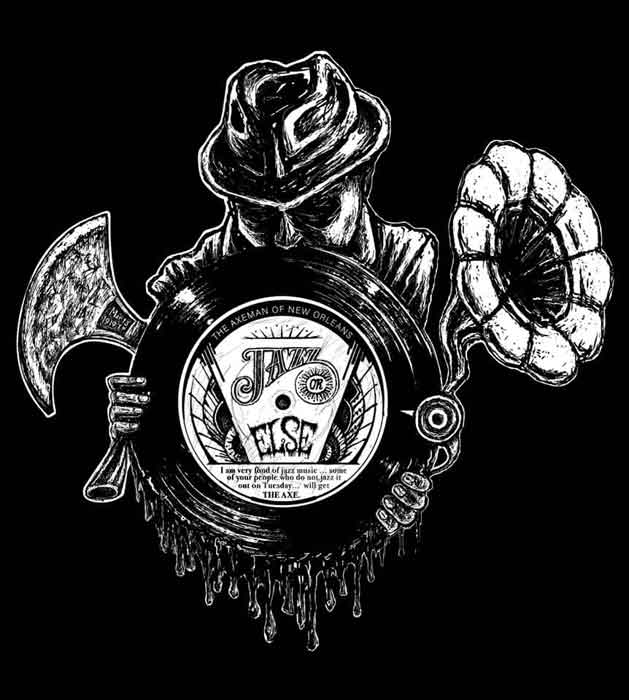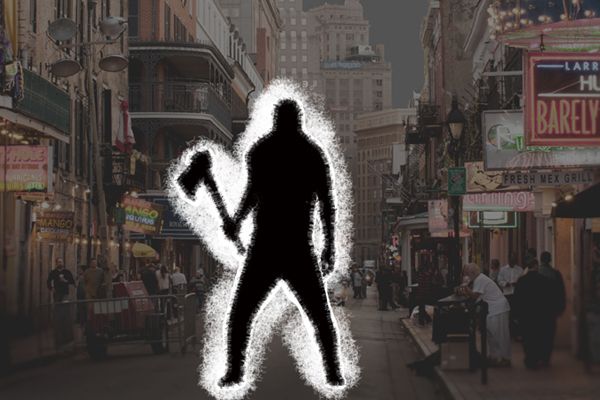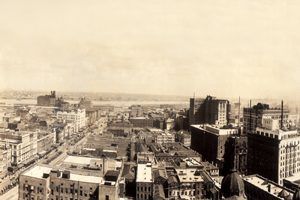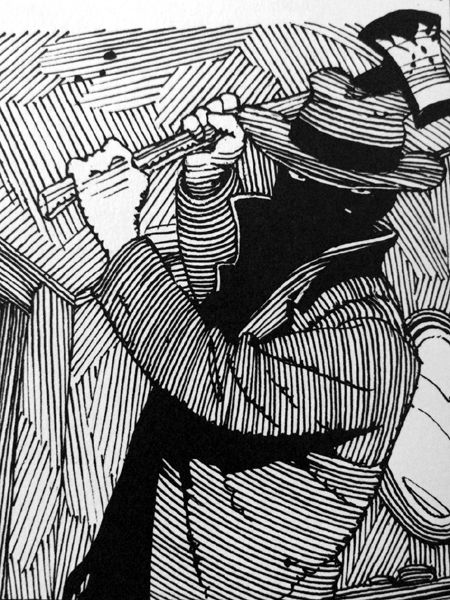
Jazz Axman of New Orleans, art by Claudia Rodriguez, Wrought Ink
“Who’ll be next?” is the question being asked by detectives and Italians of New Orleans. \
— The Times-Picayune
For over a year, from May 1918 to October 1919, the city of New Orleans, Louisiana was in a frenzied panic over a roaming serial killer dubbed the “Axeman”. The first to succumb to the sharp blade of the Axeman was an Italian grocer named Joseph Maggio and his wife, Catherine, on May 23, 1918. As they lay sleeping in their apartment above the Maggio grocery store, the killer cut the couple’s throats with a straight razor before bashing in their heads with an ax. When law enforcement began to investigate, they found the bloody clothes of the murderer, as he had obviously changed into a clean set of clothes before fleeing the scene. Police ruled out robbery as motivation for the attacks, as the intruder did not steal money and valuables left in plain sight. Near the couple’s home, a message written in chalk read: “Mrs. Joseph Maggio will sit up tonight. Just write Mrs. Toney”. Investigators immediately questioned several people but all were released for lack of evidence.
A little more than a month later, another couple was attacked in the early morning hours of June 27, 1918. Louis Besumer, a grocer, and his mistress, Harriet Lowe, lived in quarters at the back of the store. When no one opened the store in the morning, they were discovered lying in a pool of blood. Besumer had been struck with an ax above his right temple, and Lowe was hacked over the left ear. Though badly injured, both were still alive. Once again, people were questioned, and one man was arrested, but they were later released. Though the crime made the newspapers, of bigger note to some was the “scandal” of the mistress. After the attack, one side of Lowe’s face was partially paralyzed, and on August 5th, she had surgery performed in an effort to correct it. Two days later, she died, but before she passed, she told authorities that she suspected it was Louis Besumer who had attacked her. Besumer was then charged with murder and served nine months in prison before being acquitted on May 1, 1919, after a ten-minute jury deliberation.
On August 5, a third similar attack was made on Mrs. Edward Schneider, who was eight months pregnant. As the 28-year-old lay in bed, she awoke to see a dark figure standing over her and was bashed in the face repeatedly. Shortly after midnight, she was discovered by her husband, who was just returning from work. Her scalp had been cut open, and her face was completely covered in blood, but she survived the attack to give birth to a healthy baby girl two days later. One man was arrested on suspicion but soon released for lack of evidence. By this time, investigators began publicly speculating that the attack was related to the previous incidents involving Besumer and Maggio.
Just five days later, yet another grocer, a man named Joseph Ramano, was attacked on August 10th. The elderly grocer lived with his two nieces, who awoke to the sound of a commotion in the adjoining room where their uncle resided. The girls entered Ramoano’s room to find that he had taken a serious blow to his head and saw the assailant was fleeing. The grocer, though seriously injured, was able to walk to the ambulance once it arrived, but he died two days later due to severe head trauma. The girls were able to provide a brief description of the killer — a dark-skinned, heavy-set man who wore a dark suit and slouched hat.

The Axeman of New Orleans
Other clues of the crime were similar to the previous ones, such as the scenes were often ransacked but nothing was ever stolen, that the killer used the owner’s hatchets and blades, that panels of doors or windows were chiseled away to gain entry, and that the majority of the victims were Italian.
Yet another in a series of murders and assaults by the Axeman created sweeping fear in the city. Police were inundated with reports from citizens claiming to have seen an axeman lurking in neighborhoods, axes chisels found in backyards, and doors and windows that appeared to have been tampered with. People began to carry loaded shotguns, and family members took turns watching over their families at night. One report alleged that the Axeman was masquerading as a woman and another that he had been seen leaping over a back fence.
The people were afraid, determined to protect themselves, and bordered on panic. But, perhaps the heat generated by that terror was somehow transferred to the Axeman, as the killings and assaults stopped as quickly as they had started.
Over the months, the fear waned, and the neighborhoods returned to normal until March 10, 1919, when the Axeman struck again. Charles Cortimiglia was an immigrant and grocer who lived with his wife, Rosie, and two-year-old daughter, Mary, in the town of Gretna, just across the Mississippi River from New Orleans. When screams came from the Cortimiglia residence in the early morning hours, neighboring grocer Lorlando Jordano rushed across the street to investigate. There, he found that the three had been attacked.

New Orleans, Lousiana in 1919
Rosie had awakened to find her husband struggling with a large man wielding an axe. When her husband fell to the floor, the assailant turned on her as she held her daughter and begged for their lives. Undaunted, the killer slammed the axe down on both mother and daughter.
When the neighbor arrived, Charles lay in a pool of blood on the floor as Rosie stood in the doorway with a serious head wound, clutching her deceased daughter. The couple was rushed to the hospital, where both were treated for skull fractures. Charles was released two days later, while his wife remained in the care of doctors.
Upon gaining full consciousness, Rosie stated that the attack was made by neighboring grocer Lorlando Jordano and his 18-year-old son, Frank. Though Lorlando, a 69-year-old man, was in too poor of health to have committed the crimes, and Frank Jordano was too big to have fit through the panel in the back door, the pair were arrested. Though Charles Cortimiglia denied his wife’s claims, the Jordanos were charged with the murders and would later be found guilty. Frank was sentenced to hang, and his father to life in prison. After the trial, Charles divorced his wife. About a year later, Rosie Cortimiglia reversed her claim, stating that she had falsely accused the two out of jealousy and spite. Her claim was the only evidence against the Jordanos, and they were released from jail shortly thereafter.
Following the Cortimiglia murders, New Orleans was again filled with terror and once again began to arm themselves. The police stated that they believed all of the crimes to have been committed by the same man… “a bloodthirsty maniac, filled with a passion for human slaughter.”
Then, a new twist came upon the scene when the Times-Picayune newspaper received and taunting letter on March 14, 1919, that promised another attack:
Hell, March 13, 1919
Esteemed Mortal:
They have never caught me, and they never will. They have never seen me, for I am invisible, even as the ether surrounding your earth. I am not a human being but a spirit and a demon from the hottest hell. I am what you Orleanians and your foolish police call the Axeman.
When I see fit, I shall come and claim other victims. I alone know whom they shall be. I shall leave no clue except my bloody axe, besmeared with blood and brains of he whom I have sent below to keep me company.
If you wish, you may tell the police to be careful not to rile me. Of course, I am a reasonable spirit. I take no offense at the way they have conducted their investigations in the past. In fact, they have been so utterly stupid as to not only amuse me but His Satanic Majesty, Francis Josef, etc. But tell them to beware. Let them not try to discover what I am, for it was better that they were never born than to incur the wrath of the Axeman. I don’t think there is any need for such a warning, for I feel sure the police will always dodge me, as they have in the past. They are wise and know how to keep away from all harm.
Undoubtedly, you Orleanians think of me as a most horrible murderer, which I am, but I could be much worse if I wanted to. If I wished, I could pay a visit to your city every night. At will, I could slay thousands of your best citizens, for I am in close relationship with the Angel of Death.
Now, to be exact, at 12:15 (earthly time) on next Tuesday night [March 19, 1919}, I am going to pass over New Orleans. In my infinite mercy, I am going to make a little proposition to you people. Here it is:
I am very fond of jazz music, and I swear by all the devils in the nether regions that every person shall be spared in whose home a jazz band is in full swing at the time I have just mentioned. If everyone has a jazz band going, well, then, so much the better for you people. One thing is certain and that is that some of your people who do not jazz it on Tuesday night (if there be any) will get the axe.
Well, as I am cold and crave the warmth of my native Tartarus, and it is about time I leave your earthly home, I will cease my discourse. Hoping that thou wilt publish this, that it may go well with thee, I have been, am, and will be the worst spirit that ever existed either in fact or realm of fancy.
The Axeman

The Axeman of New Orleans
Per the killer’s statement that no one listening to jazz on March 19 would get the axe, the music flowed from homes across much of the city, dance halls were filled to capacity, and professional and amateur bands played jazz at parties at hundreds of houses around town, and no one was killed.
For several weeks, all was quiet, but people still lived in fear. On August 10, 1919, another grocer named Steve Boca was attacked in his bedroom as he slept. Boca awoke during the night to find a dark figure looming over his bed. Suffering from a blow from an axe, he survived, and upon regaining consciousness, he ran to the home of his neighbor, Frank Genusa, where he lost consciousness and collapsed. He was then treated for his injuries but was unable to remember the details of the attack. Like others who the Axeman had assailed, nothing was taken from his home and a panel on the back door of the home had been chiseled away.
On September 2, a local druggist named William Carson escaped the lethal Axeman when he fired several shots at an intruder who had broken into his home. The killer left a broken door and an ax behind.
On September 3, 1919, a young girl named Sarah Laumann was attacked with an ax while she slept in her locked and shuttered home. When neighbors came to check on the young woman, who had lived alone, they discovered her lying unconscious on her bed, suffering from a severe head injury and missing several teeth. Though she suffered from a brain concussion she recovered. A bloody ax was discovered on the front lawn of the building.
Once again, New Orleans was in a state of hysteria. But, nothing more would be heard from the Axeman for nearly two months. The last attack came on October 27, 1919, when grocer Mike Pepitone was slain. That night, his wife heard a noise and arrived at the door of the bedroom just as a large, ax-wielding man was fleeing the scene. Pepitone had been struck in the head and was covered in his own blood. His murder left his wife and six children behind. Mrs. Pepitone, the mother of six children, was unable to describe any characteristics of the killer. The usual clues had been left behind.
The authorities continued to work on the case, but it would be in vain. Pepitone’s murder was the last known of the Axeman Killer. He was never seen or heard from in New Orleans again.
©Kathy Alexander/Legends of America, updated January 2024.
Also See:
Villisca, Iowa, and the Axe-Murder Man
Famous Unsolved Crimes of America
New Orleans, Lousiana – the Big Easy
Sources:
